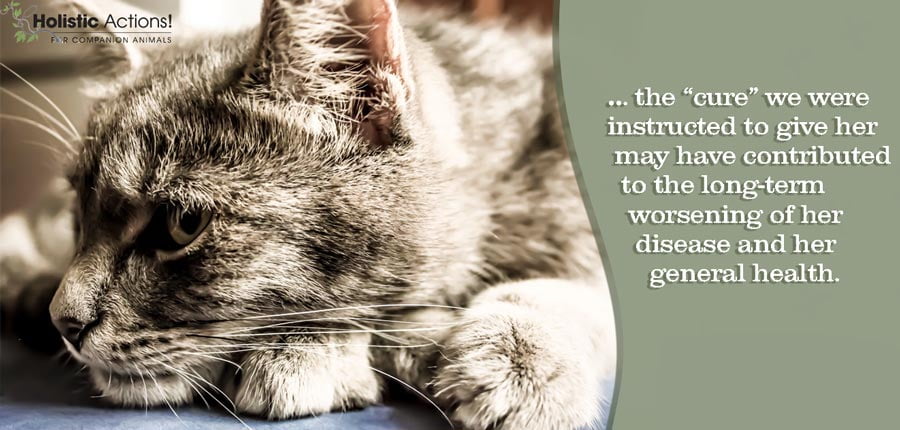It all began in 1988, when our beloved year-old tortoiseshell Persian, Dinah, developed what was diagnosed as a “granuloma” on her lip. Our then veterinarian treated her with the “accepted” method of dealing with such disorders, a cortisone injection.
The granuloma disappeared and all was well.
She developed a couple of more granulomas over the next year. We just took her to the vet, and like the first time, she was given more shots, and she was, ostensibly, healed.
In late 1989 Dinah became very ill and was diagnosed, by a different vet, with inflammatory bowel disease (IBD), a disease analogous to Krohn’s disease in humans in which perforations occur in the bowels (NB: the intestines become “leaky” but not perforated per se.) An endoscopy was performed, and the lab result came back with the statement, “Prognosis Poor”.
As one would expect, we relied on the advice of our vet at that time and followed his suggestions to alter her diet and give her only the very bland offerings of WD Prescription Diet — dry and canned foods. Additionally we were told to put Dinah on an ongoing program of prednisone, another corticosteroid drug.
For four years we continued this regimen. Dinah occasionally had recurrences of the disease, and we would increase the dosage of the prednisone until the symptoms would subside.

We were then told by our new vet, Dr. Jeff Feinman, about the fresh food diet and some of the naturopathic treatments available for animals, and we began reading all we could get our hands on.
…we hadn’t known that there were natural alternatives for animals!
Interestingly enough we, as humans, eat very healthily and take no drugs whatsoever, rarely even aspirin. It was strange that we had not thought this could also apply to our pets, but we hadn’t known that there were natural alternatives for animals! After much reading and with Dr. Feinman’s guidance, we decided to take the plunge and convert to a different, non-drug approach.
We converted the diets of all four of our cats to a diet of purer “whole foods”. We began to make their food in larger batches, freezing it in smaller, manageable amounts: lamb or turkey, with brown rice or potatoes, squash and some clover sprouts. For Dinah we added additional herbal remedies such as apple pectin and liquid chlorophyll to control any bowel irregularities. We also gave her slippery elm syrup before each meal to soothe her stomach.
Well, the results have been phenomenal!!
Before the change in diet, and herbal treatments, Dinah had always been listless; she had gained weight and disliked being touched because, we assumed, she was “tender”. She would never even jump into a windowsill. Her coat had a greasy feel, and she would have dandruff.
Within a month of her new diet and herbal therapy, she had changed unbelievably. Her weight went down and she became increasingly more playful, now jumping wherever she wanted. Her coat became as luxurious as it had been when she was a kitten.
What is so ironic in this was our recent discovery that the “cure” we were instructed to give her, the corticosteroid treatments, may have contributed to the long-term worsening of her disease and her general health.
We suspect that the disease may have started as an allergic response to something (possibly insecticides in a flea shampoo) and could have been treated herbally or even ignored if the inciting cause had been found and eliminated!!
Our cats are living wonderful proof that diet is the most important element of their lives.
~ Dinah’s mom
